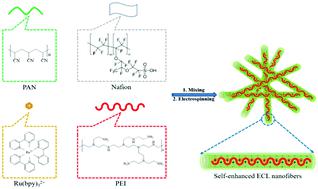当前位置:
X-MOL 学术
›
J. Mater. Chem. B
›
论文详情
Our official English website, www.x-mol.net, welcomes your feedback! (Note: you will need to create a separate account there.)
Ultrasensitive self-enhanced electrochemiluminescence sensor based on novel PAN@Ru@PEI@Nafion nanofiber mat.
Journal of Materials Chemistry B ( IF 7 ) Pub Date : 2020-04-29 , DOI: 10.1039/c9tb02287b Libo Li 1 , Limin Zhou , Xiaohong Liu , Tianyan You
Journal of Materials Chemistry B ( IF 7 ) Pub Date : 2020-04-29 , DOI: 10.1039/c9tb02287b Libo Li 1 , Limin Zhou , Xiaohong Liu , Tianyan You
Affiliation

|
In the present work, a novel self-enhanced electrochemiluminescence (ECL) composite was for the first time prepared by simply electrospinning a mixture of polyacrylonitrile (PAN), Ru(bpy)32+, poly(ethylenimine) (PEI) and Nafion, and defined as PAN@Ru@PEI@Nafion nanofiber mat (PAN@Ru@PEI@Nafionnfm). Herein, Ru(bpy)32+ was applied as an ECL reagent, and PEI was selected as a co-reactant due to the abundant tertiary amine groups in its backbone. In order to further improve the ECL efficiency of the Ru(bpy)32+-PEI system, we innovatively loaded Ru(bpy)32+ and PEI into PAN nanofibers simultaneously by a one-step electrospinning technique. As a result, the electronic transmission distance between them was sharply shortened. Meanwhile, with the help of electrostatic interaction between positively charged Ru(bpy)32+ or PEI and negatively charged Nafion, exfoliation of Ru(bpy)32+ and PEI from the PAN nanofiber mat was effectively avoided. As expected, the luminous nanofibers exhibited excellent ECL performance including high efficiency and good stability. On this basis, we fabricated a new self-enhanced ECL sensor with excellent analysis performance. Using α-naphthol as an analytical probe, the sensor showed a wide linear range from 1.0 × 10-12 to 1.0 × 10-7 M with a low detection limit of 1.0 × 10-12 M. When it was applied to detect α-naphthol from carbaryl hydrolysis, the results were well consistent with those obtained from the high efficiency liquid chromatography-diode array detector (HPLC-DAD) method, indicating the potential application of the ECL sensor in real sample assays.
中文翻译:

基于新型PAN @ Ru @ PEI @ Nafion纳米纤维垫的超灵敏自增强电化学发光传感器。
在本工作中,首次通过简单地电纺聚丙烯腈(PAN),Ru(bpy)32+,聚(乙烯亚胺)(PEI)和Nafion的混合物,首次制备了一种新型的自增强电致发光(ECL)复合材料。定义为PAN @ Ru @ PEI @ Nafion纳米纤维垫(PAN @ Ru @ PEI @ Nafionnfm)。在此,Ru(bpy)32+被用作ECL试剂,并且由于其骨架中的叔胺基团丰富,因此选择PEI作为共反应物。为了进一步提高Ru(bpy)32 + -PEI系统的ECL效率,我们通过一步电纺技术将Ru(bpy)32+和PEI创新地同时加载到PAN纳米纤维中。结果,它们之间的电子传输距离大大缩短了。同时,借助带正电的Ru(bpy)32+或PEI与带负电的Nafion之间的静电相互作用,有效避免了PAN纳米纤维毡中Ru(bpy)32+和PEI的剥落。如预期的那样,发光纳米纤维表现出优异的ECL性能,包括高效率和良好的稳定性。在此基础上,我们制造了具有出色分析性能的新型自增强ECL传感器。使用α-萘酚作为分析探针,该传感器显示出从1.0×10-12到1.0×10-7 M的宽线性范围,低检测限为1.0×10-12M。甲萘威水解萘酚得到的结果与高效液相色谱-二极管阵列检测器(HPLC-DAD)方法获得的结果完全一致,表明ECL传感器在实际样品分析中的潜在应用。发光纳米纤维表现出优异的ECL性能,包括高效率和良好的稳定性。在此基础上,我们制造了具有出色分析性能的新型自增强ECL传感器。使用α-萘酚作为分析探针,该传感器显示出从1.0×10-12到1.0×10-7 M的宽线性范围,低检测限为1.0×10-12M。甲萘威水解萘酚得到的结果与高效液相色谱-二极管阵列检测器(HPLC-DAD)方法获得的结果完全一致,表明ECL传感器在实际样品分析中的潜在应用。发光纳米纤维表现出优异的ECL性能,包括高效率和良好的稳定性。在此基础上,我们制造了具有出色分析性能的新型自增强ECL传感器。使用α-萘酚作为分析探针,该传感器显示出从1.0×10-12到1.0×10-7 M的宽线性范围,低检测限1.0×10-12M。甲萘威水解萘酚得到的结果与高效液相色谱-二极管阵列检测器(HPLC-DAD)方法获得的结果完全一致,表明ECL传感器在实际样品分析中的潜在应用。
更新日期:2019-12-06
中文翻译:

基于新型PAN @ Ru @ PEI @ Nafion纳米纤维垫的超灵敏自增强电化学发光传感器。
在本工作中,首次通过简单地电纺聚丙烯腈(PAN),Ru(bpy)32+,聚(乙烯亚胺)(PEI)和Nafion的混合物,首次制备了一种新型的自增强电致发光(ECL)复合材料。定义为PAN @ Ru @ PEI @ Nafion纳米纤维垫(PAN @ Ru @ PEI @ Nafionnfm)。在此,Ru(bpy)32+被用作ECL试剂,并且由于其骨架中的叔胺基团丰富,因此选择PEI作为共反应物。为了进一步提高Ru(bpy)32 + -PEI系统的ECL效率,我们通过一步电纺技术将Ru(bpy)32+和PEI创新地同时加载到PAN纳米纤维中。结果,它们之间的电子传输距离大大缩短了。同时,借助带正电的Ru(bpy)32+或PEI与带负电的Nafion之间的静电相互作用,有效避免了PAN纳米纤维毡中Ru(bpy)32+和PEI的剥落。如预期的那样,发光纳米纤维表现出优异的ECL性能,包括高效率和良好的稳定性。在此基础上,我们制造了具有出色分析性能的新型自增强ECL传感器。使用α-萘酚作为分析探针,该传感器显示出从1.0×10-12到1.0×10-7 M的宽线性范围,低检测限为1.0×10-12M。甲萘威水解萘酚得到的结果与高效液相色谱-二极管阵列检测器(HPLC-DAD)方法获得的结果完全一致,表明ECL传感器在实际样品分析中的潜在应用。发光纳米纤维表现出优异的ECL性能,包括高效率和良好的稳定性。在此基础上,我们制造了具有出色分析性能的新型自增强ECL传感器。使用α-萘酚作为分析探针,该传感器显示出从1.0×10-12到1.0×10-7 M的宽线性范围,低检测限为1.0×10-12M。甲萘威水解萘酚得到的结果与高效液相色谱-二极管阵列检测器(HPLC-DAD)方法获得的结果完全一致,表明ECL传感器在实际样品分析中的潜在应用。发光纳米纤维表现出优异的ECL性能,包括高效率和良好的稳定性。在此基础上,我们制造了具有出色分析性能的新型自增强ECL传感器。使用α-萘酚作为分析探针,该传感器显示出从1.0×10-12到1.0×10-7 M的宽线性范围,低检测限1.0×10-12M。甲萘威水解萘酚得到的结果与高效液相色谱-二极管阵列检测器(HPLC-DAD)方法获得的结果完全一致,表明ECL传感器在实际样品分析中的潜在应用。



























 京公网安备 11010802027423号
京公网安备 11010802027423号